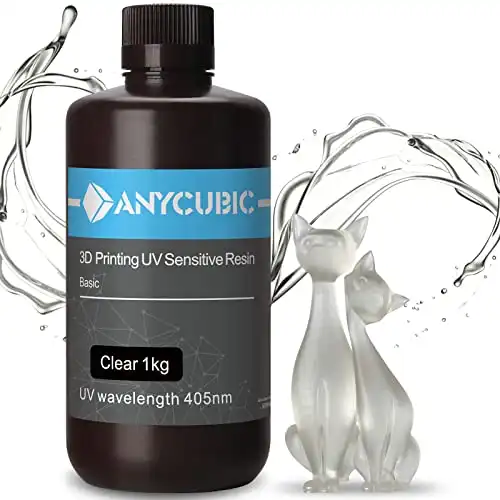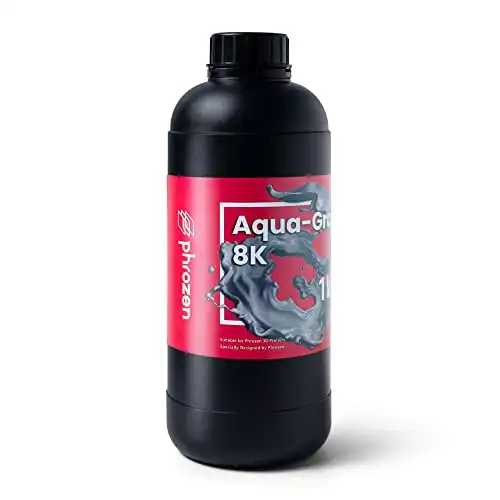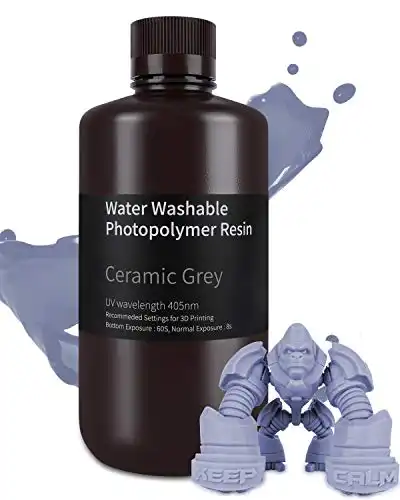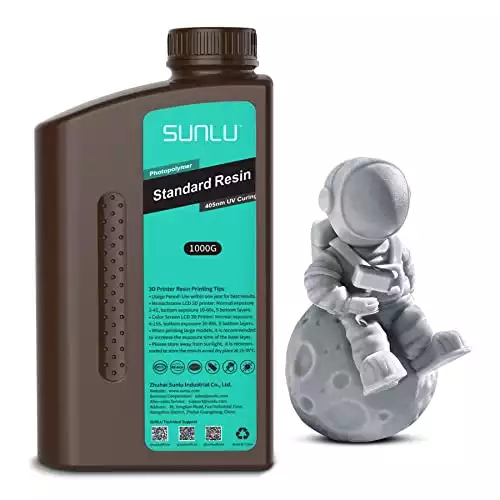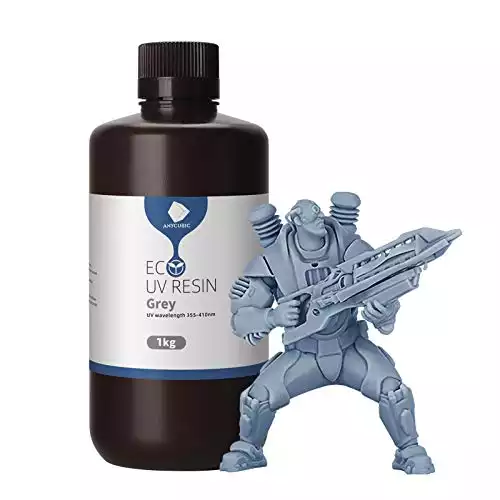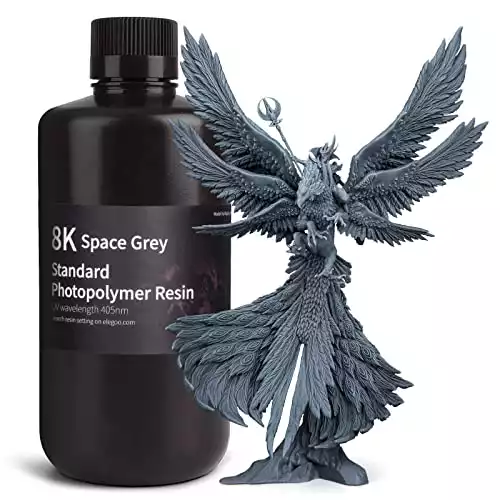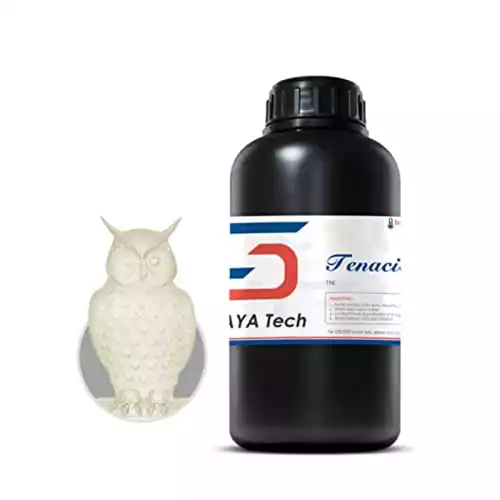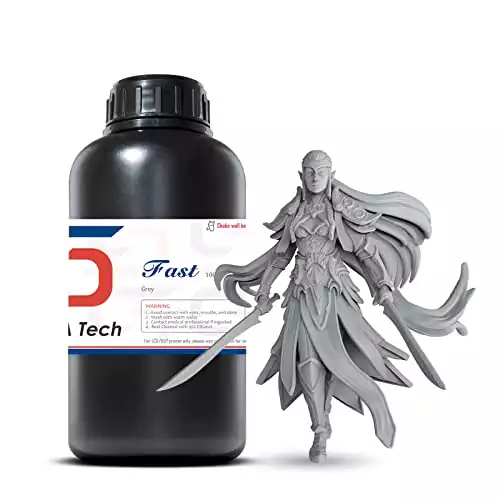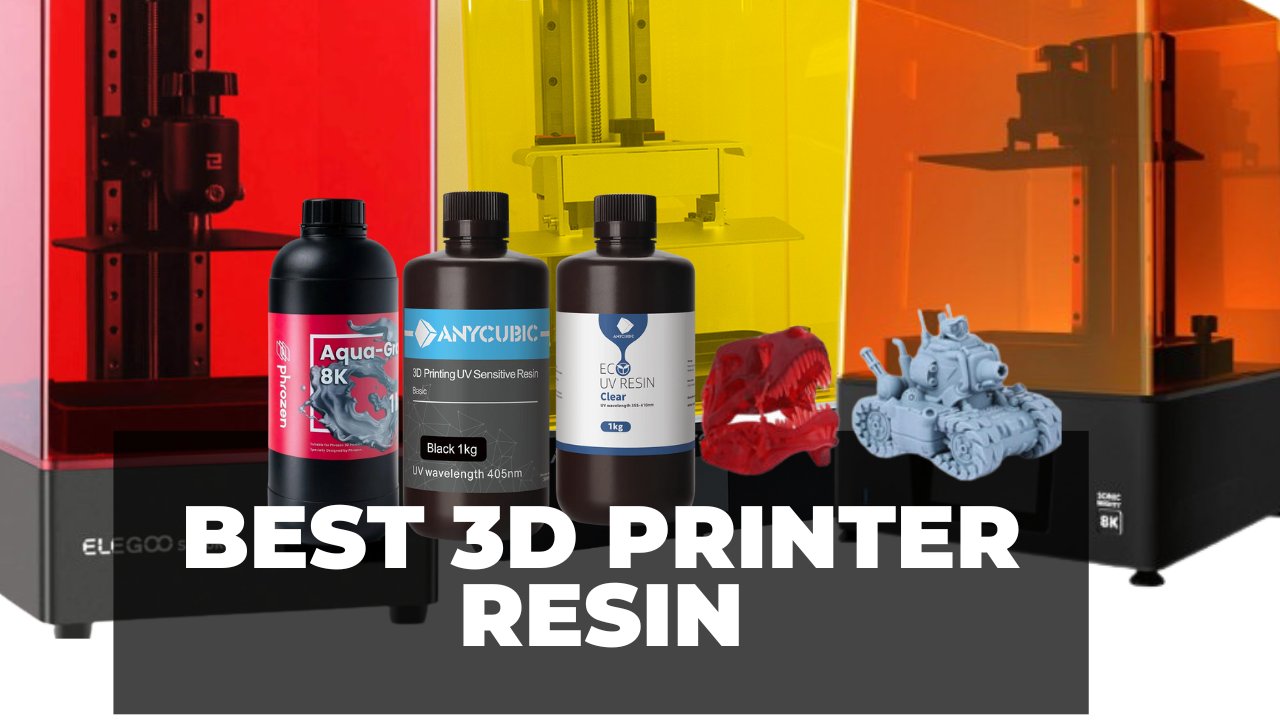
Searching for the best 3D printer resin at any of your favorite retailers turns up a dizzying range of results. Dozens and dozens in fact, with different brands, specs, types, marketing blurbs, colors, and promises of flawless prints to wade through.
|
|
|
|
|
|
|
$38.99
|
|
Bottle Size:
500 g, 1 kg, 2 kg
|
Bottle Size:
1 kg
|
Bottle Size:
500 g, 1 kg
|
|
Color Options:
White, PeachPuff, Aqua Blue, Black, Grey, Clear, Translucent Green
|
Color Options:
Grey, Vanilla, Snow Grey, Red Clay
|
Color Options:
White, Grey, Beige, Yellow, Green, Clear Blue, Red, Mint Green, Smoky Black, Black
|
|
|
If you’re new to resin printing, it can feel overwhelming trying to decipher the different types and understand the jargon, and whether a resin is suited to your project. We all want a resin we can rely on to bring our projects to fruition.
In this guide, we’ll walk you through the different types of resin and flag up what we consider some of the best resins for a range of applications available on the market today.
But, before we dive in, let’s take a look at what exactly is 3D printing resin.
Best 3D Printer Resin- Full Round-Up
- Anycubic Colored UV Resin: Best Budget Standard Resin
- Sunlu Standard Resin
- Anycubic Plant-Based Resin
- Elegoo Water Washable Rapid Resin: Best Water Washable Pick
- Elegoo 8K Standard Resin
- Phrozen Aqua 8K Resin: Best 8K Resin
- Siraya Tech Tencious
- Formlabs Flexible Resin
- Siraya Tech Fast ABS-Like Resin
- Liqcreate Strong-X
What is 3D Printing Resin?
3D printing resin is a liquid chemical composition consisting of photo-sensitive polymers and other ingredients. When exposed to UV light, such as by a 3D resin printer, the resin solidifies, eventually forming the final print.
What’s the difference between 3D printer resin and standard resin?
3D printer UV resin differs from traditional resin, which is used for casting and molding. Standard resin sets over time as it interacts with a curing agent, causing the resin to harden, and doesn’t require UV light to solidify like 3D printer resin does.
However, the two types are similar in their potential hazardous properties:
- In its liquid form, 3D printing resin is an irritant that can damage skin, and produces toxic, pungent fumes.
- Similarly, resin casting produces dust particles that can be responsible for respiratory issues.
- These safety precautions and equipment apply to both methods: nitrile gloves, protective eyewear, and ventilation.
To further complicate matters, different 3D printing resin techniques employ different technologies – SLA, LCD, and DLP mainly. It’s therefore important to buy a resin that’s suited to your type of resin 3D printer.
Fortunately, most consumer-grade printers for hobbyists are SLA resin printers, and retailers tend to focus on 3D printing resin for these machines rather than more niche alternatives.
But, even with 3D printing resin for SLA printers, there are different types. It’s important to understand what each one offers and for what type of applications they are suited. These include types like standard resin, water-washable resin, tough resin, draft resin, flexible resin, and 8K resin.
Below, we’ll walk you through the most popular types of resin along with a few specialist types.
What Types of Resin Is Used for 3D Printing?
- Standard Resin – This is your basic resin, used for general-purpose resin 3D printing. If in doubt, this is the resin to start with and it tends to produce consistent results, but aren’t known for their durability or strength. Popular applications include decorative pieces and miniatures.
- Water-Washable Resin – Standard resin requires cleaning is abrasive, and expensive, isopropyl alcohol, to remove excess liquid resin. Water-washable resins remove the need to do this by making the resin soluble in water, cutting costs and making post-processing a little less daunting for beginners. This resin does come with some downsides, though, chiefly lower strength and durability, partly because they absorb ambient moisture, which makes them brittle. For more details, head to our dedicated guide to water-washable resins.
- Tough, ABS-Like Resin – As the name implies, Tough resins are designed to be more resilient and stronger than standard resin thanks to weaves in additives to classic resin chemical composition. Also known as ABS-like, these tough resins aim to match the surface finish and durability of ABS filament, favored for its high tensile strength. For a deeper dive into everything tough resins have to offer, check out our dedicated guide.
- Flexible Resin – Another resin with a clue in the name, flexible resins are designed to offer higher elasticity than other resin types. Among the benefits of this is better resistance to impact, hardness, and excellent durability even under heavy loads. Think resin that when cured takes on the properties of rubber. Our guide to flexible resins has more details.
- Plant-Based, Eco Resin – Plant-based resins are formulated exclusively from natural, renewable products, often oils extracted from corn, soybeans, sunflowers, algae, and other plants. The main appeal is that these are eco-friendly materials free of the chemicals and additives that make up standard resin. They are recyclable and biodegradable as a consequence and largely match the properties of standard resin. Low odor is another benefit. For more details, we have a dedicated guide.
- Draft Resin – Also known as rapid resin, draft resin is designed to cure much faster (especially larger layers) than typical general-purpose resin, vastly reducing print times, which makes them a popular option for rapid prototyping and product development applications. Overall strength and detail tend to take a hit, but these are acceptable compromises when iterating on a new product.
- 8K Resin – The latest and newest resin type to hit the market, 8K resin aims to make the most of the rapid shift to ever high resolution resin printers. Though largely identical to standard resin, they tend to produce finer details on machines with 8K resolutions, but won’t produce better results on 4K or 2K printers, though they’ll work swimmingly with non-8K SLA 3D printers. As a fairly new addition to the resin line-up, 8K resin is one to keep an eye on. As more and more manufacturers jump on the bandwagon, we should see prices drop to reasonable levels before long.
- Ceramic Resin – Prints made with ceramic resin are designed to be fired in a kiln once printed, taking on the same familiar feel and finish as typical ceramics. This works by combining ceramic with polymers, the latter burning off during the firing process. The results are prized for their wear, corrosion, and thermal resistance.
- Dental Resin – Dental resins are made for digital dentistry applications such as modeling, prototypes, crowns, bridges, mouthguards and other in-mouth dental products. As a specialty resin, dental resin tends to be expensive and only shines in dental applications.
- Engineering – This resin type is made for engineering applications such as product design, testing, prototyping, and functional parts thanks to properties that include high-tensile strength, rigidity, toughness, durability, and resistance to high temperatures. You’ll also find engineering resins that pivot the other way, offering elasticity and resistance similar to silicone and TPU for functional end products subject to heavy wear and tear.
Best 3D Printer Resins
Standard Resin
Anycubic Colored UV Resin – Best General Purpose Resin
- Price: Check latest price at Amazon here
- Bottle Size: 500 g, 1 kg, 2 kg
- Colors: White, PeachPuff, Aqua Blue, Black, Grey, Clear, Translucent Green
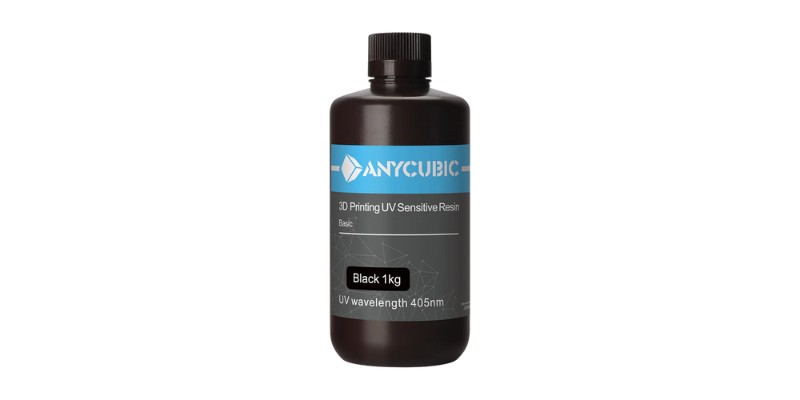
Anycubic is known for producing some of the most enticing budget resin printers, and their Anycubic Standard Resin is no different. It combines a great price with a reliable, quality material fit for a range of general-purpose applications, including miniatures, figurines, ornamental pieces, and more.
Overall, the print results are hard to fault, and Anycubic standard resin rises to the occasion for all types of models. It may not offer the same level of detail as more premium resins, but the difference is only noticeable on closer inspection. Though fairly tough, the resin can be quite brittle, with a small elongation on break, which can cause features like limbs or weaponry to snap off quite easily on smaller models like minis.
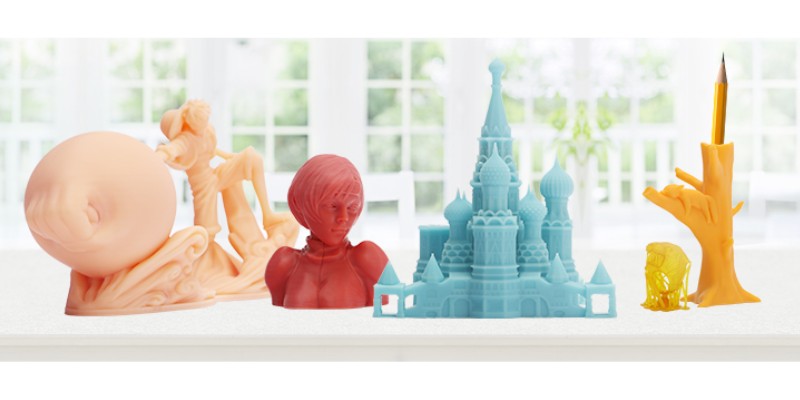
These minor negatives are balanced out by consistent results, and, in our experience, very few print errors are attributable to the resin itself. Furthermore, support removal is both easy and relatively clean, with only the occasional blemish left on models that’s easily smoothed over in post-processing.
As far as resins go, Anycubic Colored UV Resin is slightly less smelly than comparable standard resins out there. For anyone who has run a resin printer for more than a few hours, less odorous fumes can make a huge difference – especially if you work in a tight work area or apartment.
Sunlu Standard Resin – Best Cheap Resin
- Price: Check latest price at Amazon here
- Bottle Size: 500 g, 1 kg, 2 kg
- Colors: Black, Grey, Beige, Transparent, Transparent Green, Transparent Blue, Transparent Red, Dark Grey
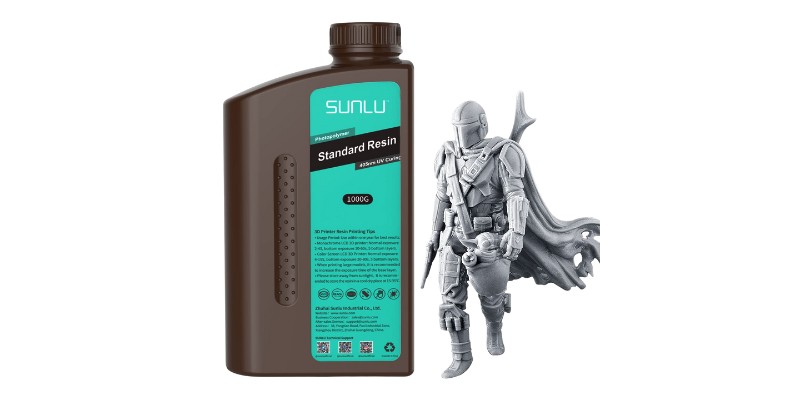
Sunlu may not have the reputation of some of the resin world’s heavy hitters, but don’t let that put you off. Sunlu Standard Resin is somewhat of a silent hero for many makers out there, and not just because it’s incredibly affordable – often as low as $12 for a 500 ml bottle. Even a 2 kg bottle can cost as little as $35.
Price aside, Sunlu’s resin offers some of the best performance value on the market, with solid rigidity for what is a no-frills resin. Low shrinkage properties means it plays nicely with multi-part models that require gluing post-print, which makes it suitable for larger figurines, for example. Dimensional accuracy is solid as well, with decent detail for the price, though a little behind more expensive resins, but as expected in this price range.

Though possibly an inconsequential point for many, the shape of the bottom wins points. It’s designed for easy pouring, mitigating the risk of a messy accident. All the specifications and recommendations for exposure times, number of bottom layers, and so on are all listed on the front of the bottle for easy reference, which isn’t something we see all manufacturers do, though they should.
Plant-Based, Eco Resin
Anycubic Plant-Based Resin – Best Environmentally-Friendly Resin
- Price: Check latest price at Amazon here
- Bottle Size: 500g, 1kg
- Colors: White, Black, Tran-Green, Grey, Pink, Yellow, Clear
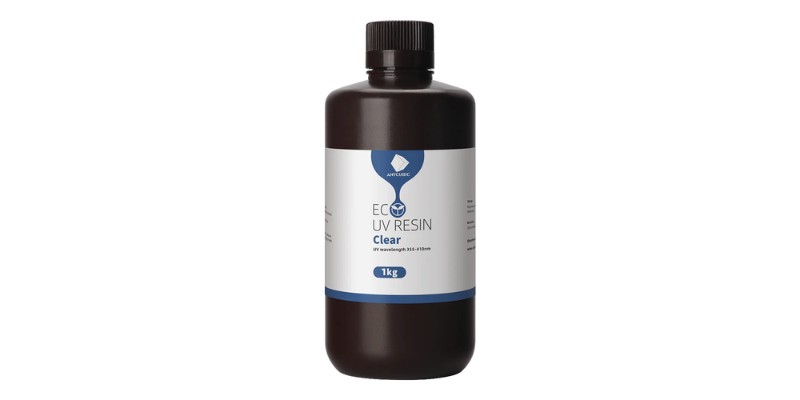
For all its capacity to create stunning models and parts, resin remains harmful for both users and the environment. To lessen the environmental impact, Anycubic has formulated a plant-based resin. It is made of soybean oil and is fully biodegradable, with no VOCs, BPA, or other toxic chemicals to sour the composition.
This is all well and good, but what makes Anycubic Plant-Based Resin such a worthwhile investment is how well it mimics full-fat resin when it comes to the quality of the final products. It is on par with similar-priced value resins. Models come out bearing the heaps of detail we’ve come to expect from SLA resin printing.

The colors are also extremely clean and tend to pop when they come off the print bed. The range of colors is also fairly decent for SLA resin. While many manufacturers stick to one or two, Anycubic offers seven different colors to choose from to suit your project’s needs.
Prints made using Anycubic Eco-Resin have a degree of flexibility which helps with durability. This added peace of mind that the model won’t immediately snap if accidentally dropped on the floor makes it a strong choice for medium-wear applications like tabletop gaming miniatures.
Water-Washable Resin
Elegoo Water Washable Rapid Resin – Best Resin For Easy Cleaning
- Price: Check latest price at Amazon here
- Bottle Size: 500 g, 1 kg
- Colors: White, Grey, Beige, Yellow, Green, Clear Blue, Red, Mint Green, Smoky Black, Black
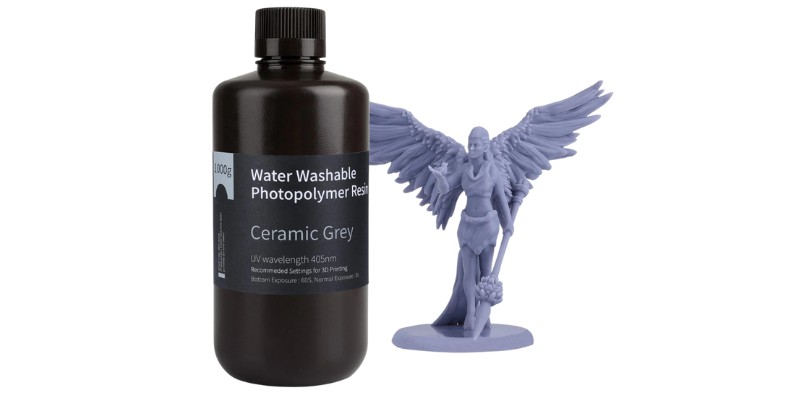
IPA is a nasty chemical. Whether the fumes or the irritation it causes when it touches the skin, it’s one of the more unpleasant aspects of resin printing.
With its Water Washable Rapid Resin, Elegoo aims to remove IPA from the equation entirely – printed parts can be cleaned using simple water – while still maintaining the value and affordability found in its standard resin line-up. It also comes in a good range of colors, a welcome change from the one or two colors we’ve come to expect from more specialist resins.
And, put to the test, there’s no difference in terms of cleaning effectiveness versus standard resin and IPA. No residue or sticky areas – the water performs just as well as IPA to prepare prints for curing. The only downside is a slightly longer drying time.
A further benefit of Elegoo’s water-washable resin is that it doesn’t carry the acrid smell of normal resin, great for tight workspaces or where ventilation isn’t quite what it should be. This also carries over the detail on offer here, with next to no difference to Elegoo standard resin, for example.
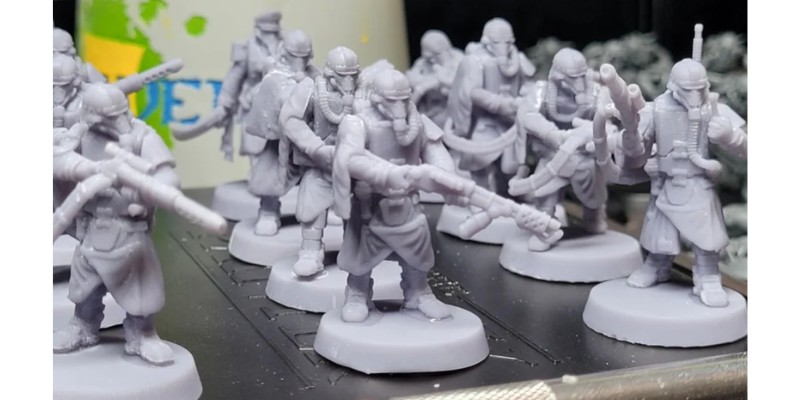
But, this comes with a caveat – water-washable resin is more brittle and less durable than typical resin. As such, it isn’t well suited to small, intricately detailed prints such as miniatures. These can snap quite easily, especially when handled during a gaming session. As such, stick to larger parts like figurines, terrain, and other ornamental pieces.
Do note that despite the suggestion that the resin is less toxic than typical resin, it is just as harmful to both humans and the environment, especially if disposed of in municipal sewer systems. It is therefore important to cure any residual resin, whether on gloves, paper, or in the water used to clean the part as you would standard resin. The same safety precautions apply as well, so always wear gloves and eyewear when handling the resin.
8K Resin
Elegoo 8K Standard Resin – Best Value 8K Resin
- Price: Check latest price at Amazon here
- Bottle Size: 1 kg
- Colors: Space Grey
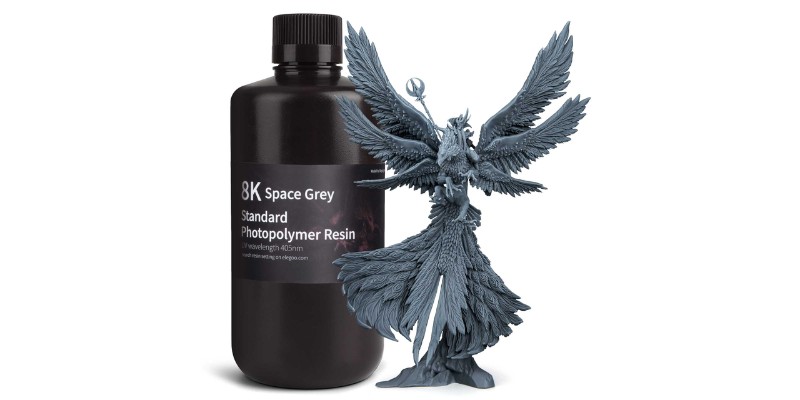
8K resin is designed to tap into the rich detail now possible with 8K resin 3D printers. Among the first to offer the resin is Elegoo, and though Elegoo 8K Standard Resin is chiefly geared toward Elegoo Saturn 2 8K machines, it is compatible with other 8K and even non-8K 3D printers.
The headline here is enhanced detail, clearer features, and a smoother surface finish. There’s a distinguishable crispness to printed parts and models that isn’t possible with typical resin.
Dimensional accuracy is fantastic thanks to low shrinkage properties, and prints look nothing short of excellent. That said, to see this difference you’ll need to have a keen eye and really get up close to the model.
Elegoo 8K Standard Resin boasts low viscosity with a consistency that’s dense and not too far removed from mixed batter. This reduces flow, which makes handling it (pouring and removing) easier, but also extends the lifespan of the FEP film as it doesn’t adhere as tightly to the print bed as typical resin.
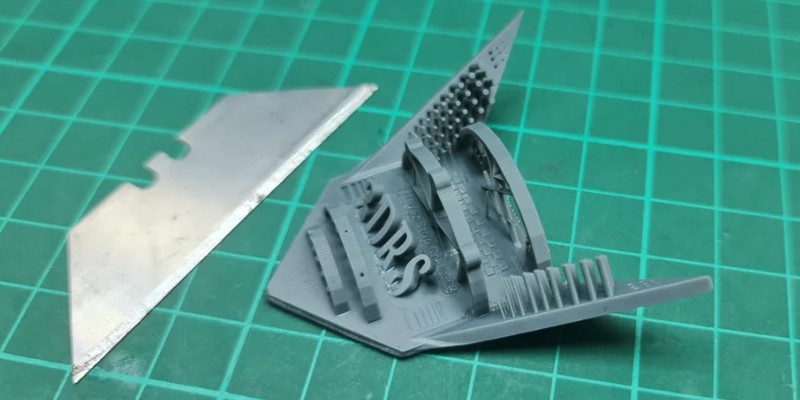
Another benefit of low viscosity is that prints are easier to remove, but you may need to dial in settings to ensure solid first-layer adhesion. The same applies to supports, which have an almost flexible resin-like quality prior to curing as opposed to the stiff, dagger-like supports that invariably pierce nitrile gloves we expect from standard resin.
Elegoo 8K Resin also comes in a water-washable variant to make post-processing a little easier, though expect to pay an extra $10 per bottle for that extra convenience.
Phrozen Aqua 8K Resin – Best 8K Resin
- Price: Check latest price at Amazon here
- Bottle Size: 1 kg
- Colors: Grey, Vanilla, Snow Grey, Red Clay
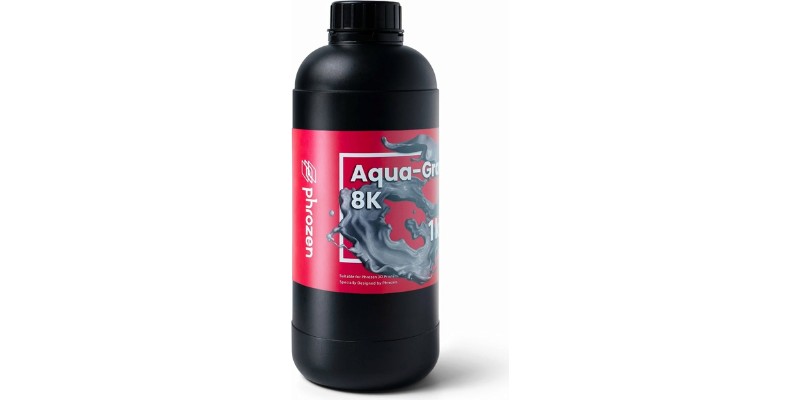
Much like Elegoo, Phrozen has formulated its own version of 8K resin geared chiefly towards the Sonic Mini 8K and the Sonic Mighty 8K, but again, it is compatible with other 8K 3D printers.
The focus is on rendering super-fine details to an extremely high standard, with excellent precision and dimensional accuracy, resulting in a clear improvement on standard resin. Printed parts take the detail up a level with clear and crisp details that would usually render with a blurred, softness on even 4K printers. If you’re looking for the pinnacle of resin details, Phrozen Aqua 8K Resin leads the charge.
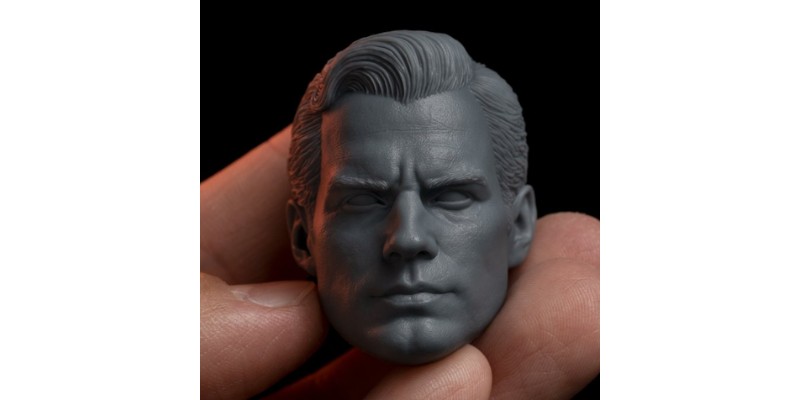
Like Elegoo, low viscosity is part of the deal here, so easier print and support removal. But, where Phrozen veered off on its own path is with a low odor composition, an advantage given that printing with 8K resins prefer slower print speeds and, therefore, longer print times.
At $50 a bottle, Phrozen Aqua 8K Resin is slightly pricier than Elegoo’s offering, but you do get the choice of four different colors as opposed to Elegoo’s fixed Space Grey. If you already own an 8K machine and want the best quality available, Phrozen Aqua 8K Resin is the resin to go for.
Flexible Resin
Siraya Tech Tenacious – Best Flexible Resin
- Price: Check latest price at Amazon here
- Bottle Size: 1 kg, 5 kg
- Colors: Clear, Obsidian Black
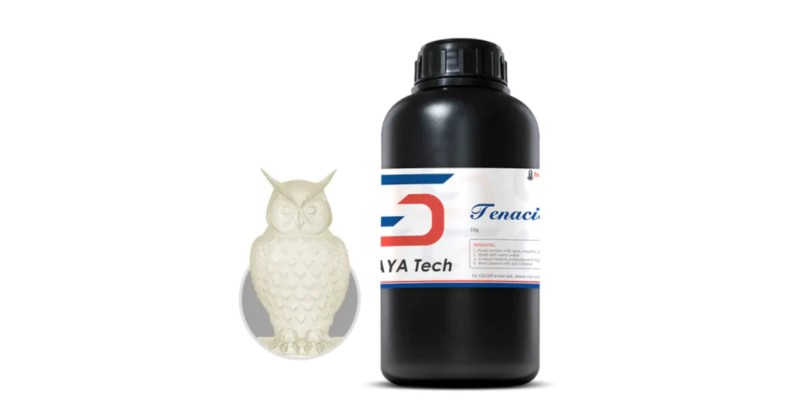
Siraya Tech Tenacious bundles in excellent strength properties suitable for functional parts, miniatures, and more. Print quality stands out for the high quality of the rendered features and details, and it’s a favorite among grassroots makers.
It can be bent, twisted, compressed, and returns effortlessly to its original shape with no loss to the structural integrity of the part or breakages. Siraya Tech Tenacious is also a popular option for mixing with other resins to boost their overall durability and flexibility.
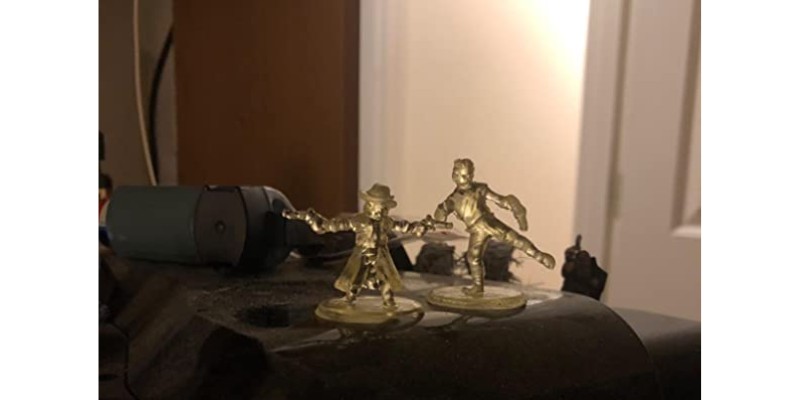
This is especially the case among miniature makers looking to mitigate the brittleness of standard resin, which often causes models to break during gaming sessions or when transported. For example, you could mix Siraya Tech Tenacious with a standard resin, like Anycubic Colored UV Resin.
Compared to standard resin it’s expensive, but reasonably affordable when viewed alongside other specialist resins, especially flexibles designed for professional applications like engineering. As such, it’s a great middle-ground option for hobbyists looking for that sweet spot between flexibility and durability, though you are limited to only two colors.
Formlabs Flexible Resin – Best Premium Flexible Resin
- Price: Check price at Dynamism here
- Bottle Size: 1 kg
- Colors: Clear Transparent
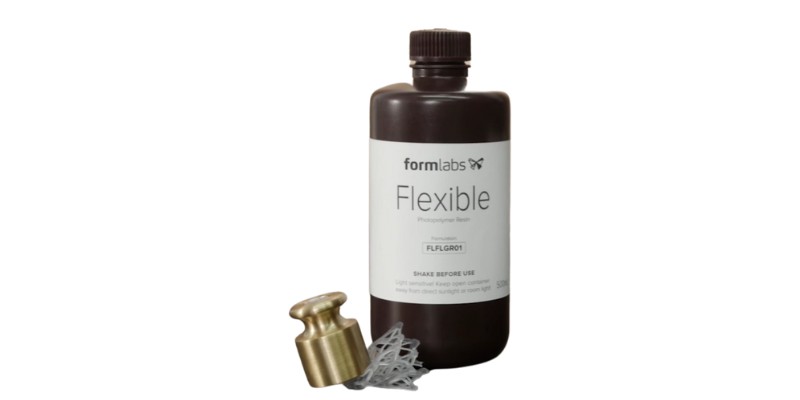
Under the flexible umbrella, Formlabs has two types distinguished by their Shore Hardness.
On one side we have Flexible 80A that is described as a ‘soft-touch material’ designed to match the qualities of rubber. It is well suited to more specialist applications that need a balance of rigidity and flexibility such as grips, handles, damping, and seals, which makes it a great option for hobbies like RC cars construction and end-use products or even engineering parts.
The other type is called Elastic 50A offers a silicone-like option for 3D printer enthusiasts and businesses. It’s also soft to the touch like the 80A type, but can withstand more flex, compression, and movement, returning to its original shape rapidly. Suitable applications include wearables, casings, and buttons, for example.
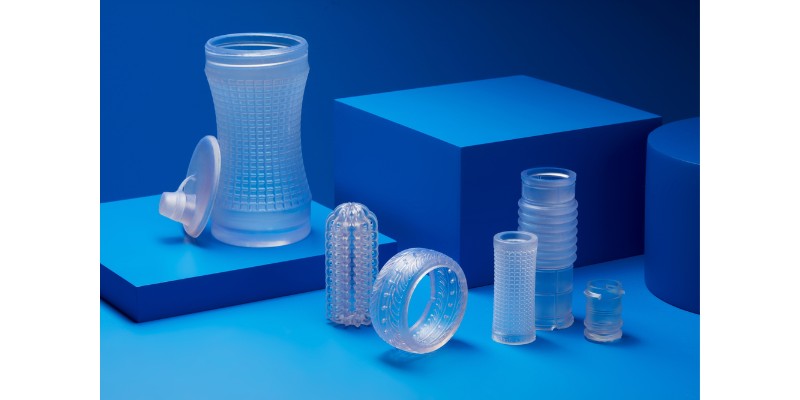
Formlabs is known for the unwavering quality of its products, and this carries over to its flexible resin line-up. The results are excellent with high levels of detail, low shrinkage, and few printing errors.
It does come at a price, and, therefore, it is primarily aimed at professionals and not hobbyists. Ideally, you’ll want to pair it with a Formlabs machine, but Formlabs Flexible Resin works equally well with other brand machines.
ABS-Like/Tough Resin
Siraya Tech Fast ABS-Like Resin – Best Resin for Durable Miniatures
- Price: Check latest price at Amazon here
- Bottle Size: 1 kg, 5 kg
- Colors: Grey, Navy Grey, Creamy, White, Smoky Black, Green, Mecha White
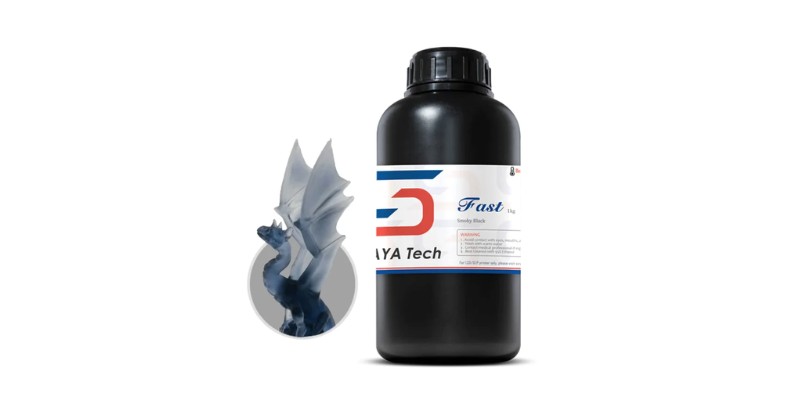
Siraya Tech continues to make a name for itself among resin enthusiasts by producing yet another resin that avoids the typically brittle resin properties with their ABS-like resin.
Mimicking the properties of FDM ABS, it’s a tough, durable resin that’s designed to take knocks and bumps yet retain its structural integrity. If you’re a tabletop gamer looking for a resin to create minis able to withstand the inevitable drops, electing to use Siraya Tech Fast ABS-Like Resin should significantly extend your models’ lifespan.
Though results vary depending on settings, the results are great when it comes to rendering complex details, especially when primed and painted, at which points the richness of the textures really comes out. This also extends to small prints like miniatures.
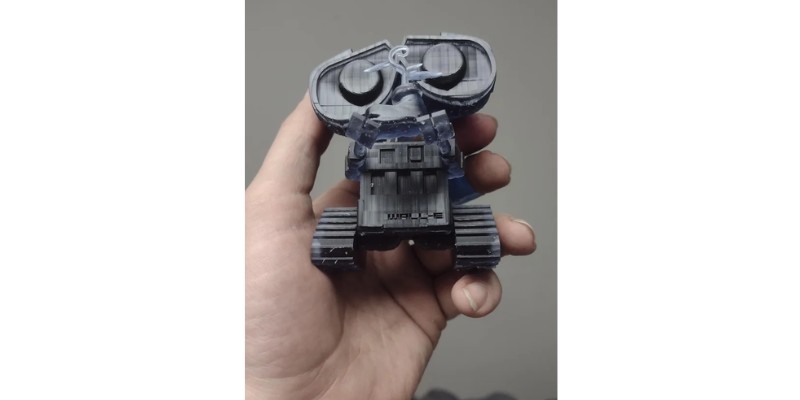
Another point to note is that Siraya Tech Fast ABS-Like Resin is slightly less pungent than typical resin, which again helps keep unpleasant odors down in confined spaces. As for the ‘Fast’ part of the titling, curing is marginally faster than typical resin, but we wouldn’t recommend this resin if speed is a top criterion when shopping for resin.
Liqcreate Strong-X – Best Tough Resin
- Price: Check price at Matterhackers here
- Bottle Size: 250 g, 1 kg
- Colors: Grey
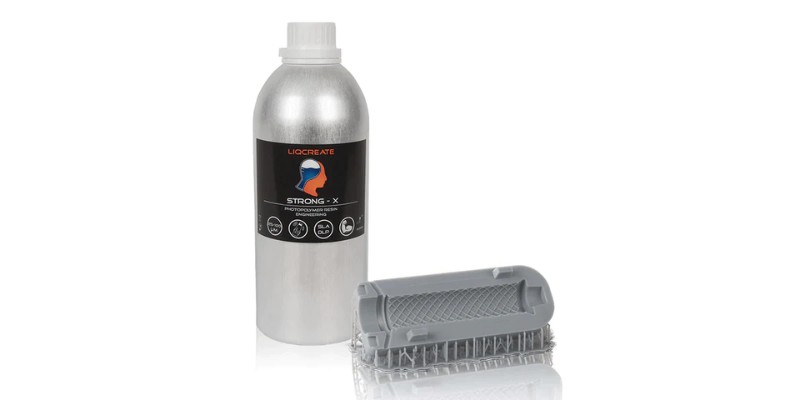
With a purported flexural strength of 135 MPa according to Liqcreate, Strong-X ranks among the toughest resins out. This remarkably positions it as a resin suitable for functional engineering projects, injection molding, and other heavy-duty applications – rather than the ornamental projects some associate with resin printing.
It’s stiff, strong, temperature resistant, and has low shrinkage. However, this focus on stiffness means it is by no means flexible with a very short elongation on break of between 4%-8%, so look to specialist flexible resins if you need a resin that snaps back after bearing heavy loads, bends, and flexing.
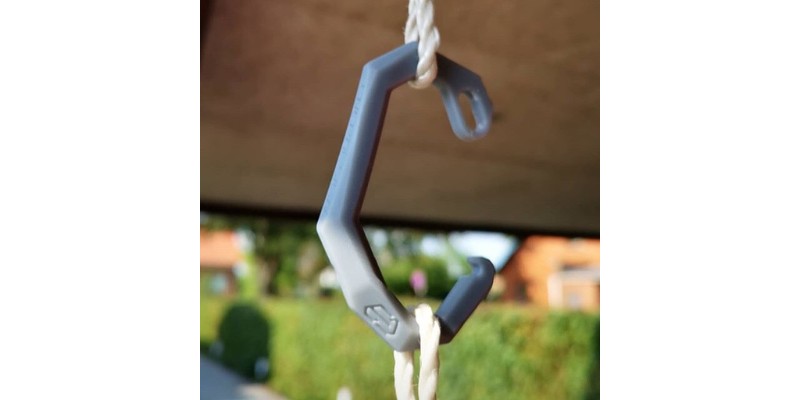
It’s also a versatile resin, and something that extends to printer compatibility with a broad light array wavelength of 385 – 405nm, making it suitable for not just consumer SLA printers but also more professionally-geared DLP machines.
A high price tag means it’s not one for the occasional maker, but one geared towards those demanding projects where durability is top of the list of required properties. $80 for a meager 250g may seem excessive, but if it fits your needs, it’s money well spent.
Buyer’s Guide – How Do I Choose a Resin for My 3D Printer?
Wavelength Compatibility
Every resin printer is equipped with a UV light array that emit light onto the resin to cure layers, one at a time, eventually creating the final print.
These arrays emit light at a specific wavelength – generally 405 nm for most consumer-grade printers. Make sure you buy resin that cures at the same wavelength that your printer emits.
In general, most standard resins are formulated to cure at anywhere from 355 nm to 410 nm, so though there’s some leeway, double-check to avoid any nasty surprises and get steady, reliable results.
Strength
Resin is much more brittle than other 3D printing materials such as FDM filaments.
While this won’t be an issue for ornamental pieces like figurines and miniatures, this can cause issues for functional applications where the part is subject to mechanical forces, wear and tear, and load bearing.
If you need extra strength and durability, consider ABS-Like and Tough resin, specifically formulated with additives to improve their impact resistance, strength, and durability. A good starting point is Siraya Tech’s Tenacious, a well-loved resin in the community for applications that need extra durability and strength.
Odors and Fumes
Odors and fumes are an unavoidable by-product of resin 3D printing, but it’s possible to find resins formulated to release less acrid and sharp odors and fumes that are less toxic and prone to causing irritation.
If you’re working in an area with poor ventilation, these are great options to limit exposure to harmful fumes. We recommend Elegoo Water Washable Rapid Resin if smells are a big concern.
Post-Processing
Depending on the chemical formulation, the curing time varies between resins. Some cure faster than others – a category known as rapid resins – which may be important if you’re on a deadline or rely on the sun to cure your prints rather than a wash and cure station.
Check manufacturer recommendations to get a sense of how long it will take – in general standard resin requires anywhere from 10 to 15 minutes to cure properly. Elegoo Rapid Resin is highly recommended for those wanting a competitive price and quick curing times.
As for washing, most resins need to be bathed in isopropyl alcohol or an equivalent cleaner like Mean Green. However, more and more water-washable resins are hitting the market all the time. As the name suggests, these resins can be cleaned using water, which greatly reduces the risks of resin printing and you don’t need to handle IPA, which is arguably more harmful than the resin itself, especially if inhaled in large quantities.
Again, Elegoo Water-Washable resins are among the best out there with great value tacked on for good measure. These include additives to remove some of the loss of strength and durability that usually happens when printing with water-soluble resins.
Color
Unlike a few years ago, when resin colors were limited to a select few, it’s now possible to buy resin in all manner of colors and shades.
Though none is inherently better than the other, consider whether you’ll be painting your prints (especially miniatures, figurines, and other decorative pieces).
If painting is on the cards, consider lighter shades, such as white, which will reduce the number of coats required. If you’re looking for the broadest range of colors, Elegoo’s standard resin leads the charge with one of the broadest ranges. It’s also competitively priced.
Brands
As with any consumer product, stick to well-known brands. Retailers like Amazon are awash with unknown brands offering too-good-to-be-true prices on resin, and you often get what you pay for – a poor-quality resin that rarely performs as well as name-brand alternatives.
Look to brands like Anycubic, Elegoo, Flashforge, eSun, Formlabs, Siraya-Tech, Liqcreate, and Phrozen for peace of mind when buying.
Price
Typically, resin is available in 500 ml and 1-liter bottles, with the price adjusted according to the volume. For standard resin, prices go from as low as $20 for 500 ml to north of $80 for 1 liter of engineering-grade resin formulated for the most demanding applications.
There’s no right or wrong price. As long as you stick to a reputable brand, buy a volume that suits your project’s scope and size, and opt for the right type of resin, it’s hard to go wrong. It may also be worth exploring how much resin you need based on whether you’re a heavy user who prints daily or only a few times a month.
For more details, check out our guide to how much you can print with 500 ml and 1 liter of resin.
FAQs
Is 3D printed resin strong?
Standard resins offer less overall strength and impact resistance than FDM filaments like PLA and ABS, and are not considered particularly strong or durable. 3D printed resin is typically fragile, brittle, and can break easily, though thicker layers, the use of supports, and the thickness of the outer walls all have an impact. Some resins such as ABS-like tough resin offer far higher tensile strength however, and is better suited to functional, prototyping, and load-bearing parts.
Is 3D printed resin aquarium safe?
Cured 3D printed is not recommended for use in aquariums, despite being largely safe to handle. It is still a synthetic material that isn’t biodegradable or designed for use in environments inhabited by fish or other animals. If you are looking to 3D print pieces for an aquarium, look to safer materials like PLA.
Is 3D printed resin food safe?
No, resin is not food safe and should never come into contact with products intended for oral consumption. This applies both to liquid and cured resin. Liquid resin is by far the most hazardous, but even cured models can retain trace amounts of liquid resin that can be harmful if ingested or touched.
Is 3D printed resin toxic?
Uncured 3D printer resin is toxic, but cured 3D printed resin is safe to touch. Uncured resin can cause irritation and other issues when it comes into contact with skin, but after curing, it is safe and much like non-resin 3D printing filaments like ABS or PLA.
Is 3D printer resin expensive?
Compared to just a few years ago, 3D printer resin is extremely affordable, with budget bottles costing as little as $20. For higher-grade resin and specialist resins such as tough resin, expect to pay $30-$40 and upwards, with premium resin costing as much as $50 for a 1-liter bottle.
Is 3D printer resin flammable?
Yes, 3D printing resin in both liquid and solid form is highly flammable and combustible. It’s important to take the necessary precautions to ensure it doesn’t come into contact with open flames, and is never left in proximity to heat sources.
Can 3D printer resin be recycled?
Standard 3D printer resin can’t currently be recycled. But, an increasing number of resin manufacturers are offering eco-friendly or plant-based resin, which is biodegradable and recyclable. This resin costs a little more than standard resin, but largely matches it in terms of properties, though it is slightly more brittle.
Can 3D printer resin be reused?
Yes, 3D printer resin still in liquid form can indeed be reused. Simply ensure you remove any cured resin and other debris that’s potentially fallen into the liquid during a previous printing process by running the liquid through a meshed sieve. These are low-cost and readily available at big online retailers like Amazon.
Can you mix 3D printer resin?
Yes, you can mix 3D printing resins as long as they have the same properties and UV cure wavelength. As long as you stick to this rule, it’s possible to mix different brands, even colors, and even standard types of resin (flexible, strong, standard) to alter the attributes of the model or part.
Can you dye 3D printer resin?
Yes, you can indeed dye 3D printed resin to create unique or surprising new colors to spice up your prints and models. However, to do this, you’ll need to use dyes and pigment sets designed specifically for 3D printing resins and not commonplace dyes like food coloring or something similar.
Does 3D printer resin expire?
3D printing resin has a shelf-life, beyond which it is considered expired and won’t produce the same quality as a factory-fresh bottle. The shelf life depends on the manufacturer, but generally, a bottle of resin has a shelf life of around 12 months. However, resin can remain viable for a few months beyond this as long as it is properly shaken and mixed before use.
Can you 3D print resin molds?
Yes, you can make resin molds using a 3D printer, though it’s important to use specialist castable resins containing wax, which are designed to handle the heat of metal casting. Standard resin may melt under the strain, making them unsuitable for casting. Note that 3D printer casting resin often requires a more involved washing, and longer curing times.
How long does 3D printer resin last?
Based on an average resin STL printer usage of 6.7 ml per hour, a 1-liter bottle of resin will last a little over 149 hours, or just under a week of continuous use. For an average user printing 10 hours a week, a 1-liter bottle of resin could last up to 15 weeks, or 3-4 months.
How dangerous is resin 3D printing?
Due to its chemical composition, 3D printer resin is considerably more toxic than FDM materials like ABS and PLA. Fumes are emitted during the 3D printing process, which can cause irritation in the lungs, and the liquid itself causes irritations when in contact with bare skin, eyes, or ingested. Fortunately, proper safety measures (gloves, protective eyewear) and proper ventilation mitigates most of the danger.
What is 3D printer resin made of?
3D printing resin consists of synthetic pigmented monomers and oligomers (usually carbon molecules) as well as photoinitiators that when exposed to UV light cure to create solid polymers in what is called the polymerization process. From there, manufacturers have their own proprietary chemical compositions, usually based on acrylate or epoxy, that include further additives to give the resin different characteristics.
What is 3D printer resin used for?
3D printer resin is used for a wide range of applications, notably those that require a higher level of detail and precision than is possible on an FDM printer. Popular applications include dentistry modeling and prosthetics, miniatures for tabletop gaming, figurines, jewelry making, design and rapid prototyping, product development, engineering, housings, enclosures, automotive and aerospace part production, and many more.
Where to buy 3D printer resin?
You can buy 3D printer resin directly from manufacturers like eSun, Anycubic, Siraya Tech, FormLabs, Elegoo, and others, or alternatively buy them from general online retailers like Amazon or specialist retailers like Matterhackers that sell 3D printers, materials, and accessories exclusively.
Why is my 3D print resin not sticking to build plate?
There are several factors that can prevent resin sticking to the build plate. Ensure your build plate is properly level by following the calibration procedure. Cleaning the build plate of any dust or resin build-up can also help with adhesion. Make sure your slicer exposure settings are in line with what’s recommended for the brand and type of resin – as a general rule you’ll want to increase the initial or first-layer exposure time. Also, make sure your model has enough contact points with the build plate – consider a raft if the problem persists. Lastly, you may also want to make marks and scratches on or sand down the surface of the build plate to make it coarser and improve adhesion.
How long does 3D printer resin take to cure?
Curing times depend on the brand of resin, but as a general rule most require anywhere from 10 to 15 minutes when exposed to a UV light in a specialized curing station. If sun curing, resin takes anywhere from 4 to 6 hours to cure completely, though this can vary depending on the amount and intensity of sunlight.
Can resin prints be left outside?
Yes, resin prints can be left outside, but due to their photosensitive nature, there’s a risk of further curing, or even overcuring the resin which can make it much harder, and therefore more brittle. This can make the resin more susceptible to fractures and breakages.
Can I use any resin with any printer?
As a general rule, you’ll want to buy resin suited to the printing technology in your specific machines – namely MSLA, LCD, and DLP systems. By doing so, you’ll ensure the resin is designed to work well with your printer by having the correct wavelengths (405nm for most consumer resin printers) and having adapted curing times when exposed to the printer’s light array.
Should you wear a mask while resin printing?
Yes, wearing a mask when using a resin printer is highly recommended. Resin produces strong fumes that aside from being foul-smelling can also cause respiratory issues when inhaled in large quantities. Alongside wearing a mask, we recommend working in a well-ventilated area where air can circulate freely – working near open windows or setting up a dedicated venting system are popular windows.
Related Articles:
